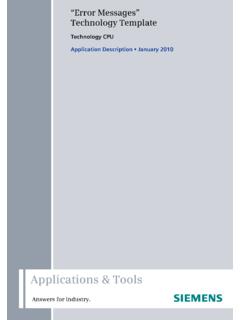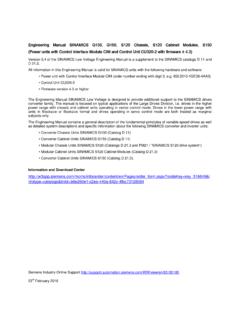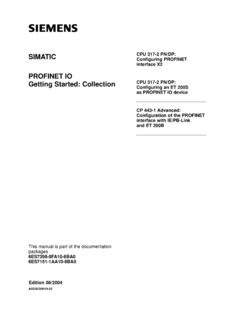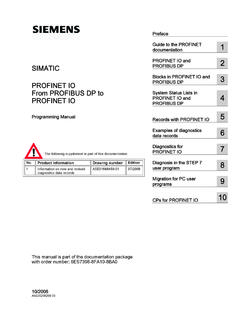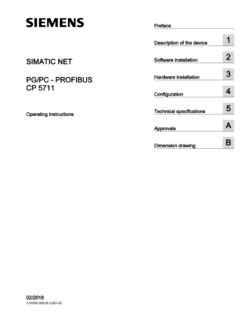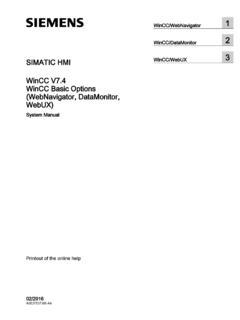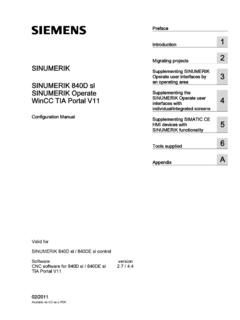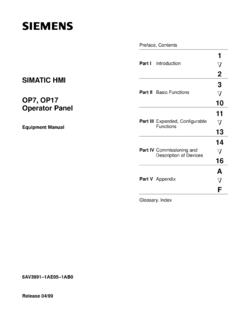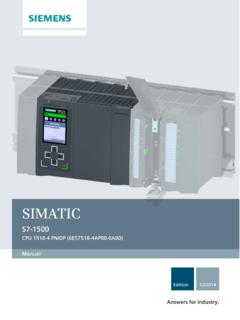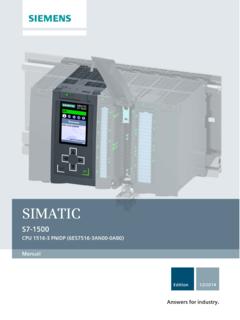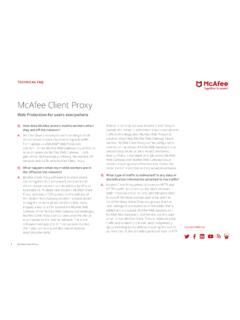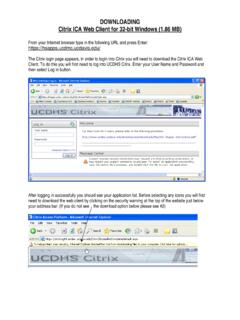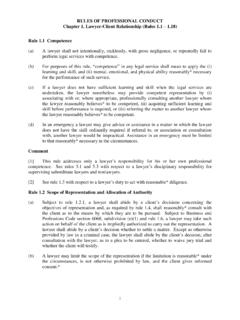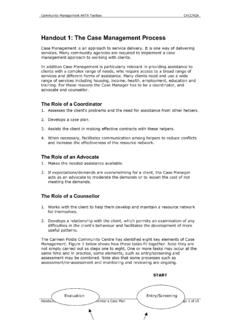Transcription of MQTT client for SIMATIC S7-1500 and S7-1200 - Siemens
1 MQTT client for SIMATIC S7-1500 and S7-1200 Blocks for S7-1500 and S7-1200 Siemens Industry Online Support Table of contents LMQTT_Client Entry-ID: 109748872, , 12/2019 2 Siemens AG 2019 All rights reserved Legal information Use of application examples Application examples illustrate the solution of automation tasks through an interaction of several components in the form of text, graphics and/or software modules. The application examples are a free service by Siemens AG and/or a subsidiary of Siemens AG (" Siemens "). They are non-binding and make no claim to completeness or functionality regarding configuration and equipment. The application examples merely offer help with typical tasks; they do not constitute customer-specific solutions. You yourself are responsible for the proper and safe operation of the products in accordance with applicable regulations and must also check the function of the respective application example and customize it for your system.
2 Siemens grants you the non-exclusive, non-sublicensable and non-transferable right to have the application examples used by technically trained personnel. Any change to the application examples is your responsibility. Sharing the application examples with third parties or copying the application examples or excerpts thereof is permitted only in combination with your own products. The application examples are not required to undergo the customary tests and quality inspections of a chargeable product; they may have functional and performance defects as well as errors. It is your responsibility to use them in such a manner that any malfunctions that may occur do not result in property damage or injury to persons. Disclaimer of liability Siemens shall not assume any liability, for any legal reason whatsoever, including, without limitation, liability for the usability, availability, completeness and freedom from defects of the application examples as well as for related information, configuration and performance data and any damage caused thereby.
3 This shall not apply in cases of mandatory liability, for example under the German Product Liability Act, or in cases of intent, gross negligence, or culpable loss of life, bodily injury or damage to health, non-compliance with a guarantee, fraudulent non-disclosure of a defect, or culpable breach of material contractual obligations. Claims for damages arising from a breach of material contractual obligations shall however be limited to the foreseeable damage typical of the type of agreement, unless liability arises from intent or gross negligence or is based on loss of life, bodily injury or damage to health. The foregoing provisions do not imply any change in the burden of proof to your detriment. You shall indemnify Siemens against existing or future claims of third parties in this connection except where Siemens is mandatorily liable.
4 By using the application examples you acknowledge that Siemens cannot be held liable for any damage beyond the liability provisions described. Other information Siemens reserves the right to make changes to the application examples at any time without notice. In case of discrepancies between the suggestions in the application examples and other Siemens publications such as catalogs, the content of the other documentation shall have precedence. The Siemens terms of use ( ) shall also apply. Security information Siemens provides products and solutions with Industrial Security functions that support the secure operation of plants, systems, machines and networks. In order to protect plants, systems, machines and networks against cyber threats, it is necessary to implement and continuously maintain a holistic, state-of-the-art industrial security concept.
5 Siemens products and solutions constitute one element of such a concept. Customers are responsible for preventing unauthorized access to their plants, systems, machines and networks. Such systems, machines and components should only be connected to an enterprise network or the Internet if and to the extent such a connection is necessary and only when appropriate security measures ( firewalls and/or network segmentation) are in place. For additional information on industrial security measures that may be implemented, please visit Siemens products and solutions undergo continuous development to make them more secure. Siemens strongly recommends that product updates are applied as soon as they are available and that the latest product versions are used. Use of product versions that are no longer supported, and failure to apply the latest updates may increase customer s exposure to cyber threats.
6 To stay informed about product updates, subscribe to the Siemens Industrial Security RSS Feed at: Table of contents LMQTT_Client Entry-ID: 109748872, , 12/2019 3 Siemens AG 2019 All rights reserved Table of contents Legal information .. 2 1 Introduction .. 4 4 Principle of operation .. 6 Components used .. 7 2 Engineering .. 9 Block description .. 9 Interface description "LMQTT_Client" .. 9 Overview of data types .. 11 LMQTT_typePublishData .. 15 Configuration .. 17 Create TIA Portal Project .. 17 Integration of the function block in the user program .. 18 Opening the global library "LMQTT_Client" .. 18 Copying function blocks and data types to the user program .. 20 Creating global data block .. 21 Calling function blocks in the user program .. 24 Configuration of the security feature.
7 26 Using the global certificate manager in the TIA Portal .. 27 Using the local certificate manager of the CPU .. 32 Parameter assignment and operation .. 35 Error handling .. 37 3 Useful information .. 41 Basics of MQTT .. 41 Terminology .. 41 Standard and architecture .. 42 Features .. 43 Structure of the MQTT control packets .. 45 MQTT connection .. 46 MQTT-push mechanism .. 49 MQTT sub-mechanism .. 52 MQTT-ping mechanism .. 55 MQTT disconnection .. 56 How the "LMQTT_Client" FB works .. 57 Requirements and implementation .. 57 State machine "TCP state machine": .. 57 State machine "MQTT state machine": .. 59 State machine "MQTT job state machine": .. 62 Function diagram .. 68 4 Appendix .. 69 Service and support .. 69 Links and Literature .. 70 Change documentation .. 70 1 Introduction LMQTT_Client Entry-ID: 109748872, , 12/2019 4 Siemens AG 2019 All rights reserved 1 Introduction Overview Motivation Digitization has a major impact on the economy and society and is progressing inexorably.
8 The "Internet of Things" (short: IoT) is one of the main drivers of digitization. The term "Internet of Things" is synonymous with one of the biggest current dynamics of change: The increasing networking and automation of devices, machines and products. The protocol "Message Queue Telemetry Transport" (short: MQTT) is used in the "Internet of Things" as a communication protocol. Its lightweight approach opens up new possibilities for automation. Slim and quick: MQTT The MQTT is a simple built-in binary publish and subscribe protocol at the TCP/IP level. It is suitable for messaging between low-functionality devices and transmission over unreliable, low-bandwidth, high-latency networks. With these characteristics, MQTT plays an important role for IoT and in M2M communication. Features of MQTT The MQTT protocol is distinguished by the following features: Lightweight protocol with low transport overhead Minimal need for network bandwidth through push mechanism Reconnect function after termination of connection Resending of messages after disconnection Mechanism for notifying prospects of an unforeseen disconnection of a client Easy to use and implement with a small set of command commands Quality Assurance (QoS level) with different levels of message delivery reliability Optional encryption of messages with SSL/TLS Authentication of publishers and subscribers with username and password Applicative implementation The "LMQTT_Client" library offers you an adequate solution for implementing the MQTT protocol in a SIMATIC S7 controller.
9 The "LMQTT_Client" library provides you with one function block each for the SIMATIC S7-1500 and SIMATIC S7-1200 . The function block "LMQTT_Client" integrates the MQTT client function and allows you to transfer MQTT messages to a broker (publisher role) and to create subscriptions (subscriber role). The communication can be secured via a TLS connection. 1 Introduction LMQTT_Client Entry-ID: 109748872, , 12/2019 5 Siemens AG 2019 All rights reserved Figure 1-1 Note The MQTT client supports MQTT protocol version 1 Introduction LMQTT_Client Entry-ID: 109748872, , 12/2019 6 Siemens AG 2019 All rights reserved Principle of operation Schematic representation The following figure shows the most important relationships between the components involved and the steps required for secured MQTT communication (MQTT over TLS).
10 Figure 1-2 BrokerMQTT serverCertificate storeidxCert_NameSTEP 7 (TIA Portal)S7-CPU(MQTT client )Cert_xyCert_xy1 MQTT over TLSE ngineering1234 Topic yMessageLMQTT_ClientConnection parametersPublishTopic xMessageTopic zMessageTopic yMessage(Un)Subscribe Table 1-1 Step Description 1 Determine the CA certificate of the MQTT broker. 2 Importing the third-party certificate into STEP 7 (TIA Portal) The certificate is now in the global certificate manager of STEP 7. 3 You must assign the imported certificate to the S7 CPU. To recognize the certificate as valid, the time of the S7-CPU must be current. 4 The function block "LMQTT_Client" assumes the following roles: Publisher to send MQTT messages to the MQTT broker Subscriber to subscribe to MQTT messages or end subscriptions The MQTT message is encrypted via a secure connection (MQTT over TLS).
